Volume 25, Issue 2
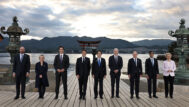
Regional Overview
May — August 2023Regional Overview: Building Partnerships Amidst Major Power Competition
Major power competition was the primary topic du jure at virtually all of this trimester’s major multilateral gatherings, with Russia’s invasion of Ukraine continuing to serve as a litmus test—a test many participants struggled to avoid taking. It was clear which side of the fence the G7 leaders stood on; Putin’s invasion was soundly condemned and Sino-centric warning bells were again gently sounded. At the BRICS Summit and Shanghai Cooperation Organization (sans the US), those alarms were clearly muted, as they were at the ASEAN Regional Forum, at which foreign ministers from all three were present. Headlines from the IISS Shangri-la Dialogue focused on the meeting that did not occur, as China’s defense minister pointedly refused to meet with his US counterpart. At the ASEAN-ISIS’ Asia-Pacific Roundtable, participants lamented the impact of major power tensions on ASEAN unity, even though ASEAN’s main challenges are internal ones that predate the downturn in China-US relations. Meanwhile, Beijing and Washington both expended considerable effort at these and other events throughout the reporting period fortifying and expanding their partnerships, even as many neighbors struggled not to choose sides or to keep a foot in both camps.
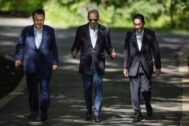
US - Japan
May — August 2023A Busy Diplomatic Calendar for Biden and Kishida
2023 is the year for the US and Japan to intensify their cooperation in multilateral venues. The first opportunity was the G7 meeting in Hiroshima in May, and the last will be the APEC meeting in San Francisco in November. In between, partners were hosting other important meetings: the NATO Summit in Lithuania and the G20 in India. Across these meetings, Russia’s war in Ukraine has stayed at the top of the agenda. The war has focused attention on the rules-based order, but global economic cooperation was not far behind. Prime Minister Kishida Fumio traveled to Africa and the Middle East to offer assistance for food insecurity and to stabilize energy markets, while President Joe Biden reached out to nations in the Indo-Pacific, including Pacific Island nations and Vietnam, to deepen strategic cooperation. China continues to loom large. The Biden administration sent three Cabinet members to Beijing for long sought consultations. Secretary of State Antony Blinken finally realized his planned trip on June 18-19. Secretary of the Treasury Janet Yellen followed on July 6-9 to meet with her counterpart, Vice Premier He Lifeng.
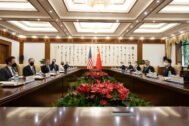
US - China
May — August 2023US-China Effort to Set “Guardrails” Back on Track for Now
The placement of the proposed “guardrails” that Joe Biden and Xi Jinping sought to erect last fall in Bali finally commenced in earnest with the visits to Beijing by three Cabinet secretaries and one National Security Council principals-level appointee. Important steps were taken to put the balloon incident behind them, with lines of communication re-opened, assurances exchanged, and incremental forward progress recorded even in areas such as export controls, where US and China had previously clashed. Defense exchanges remain an area where progress lags. Whether the “guardrails” can survive their first contact with US election year polemics remains to be seen. As ties stabilized, both sides also engaged in sanctions and countermeasures as well as domestic rulemaking to secure their national economic and security interests. All along, the administration continued building “situations of strength” with its allies and partners to shape the strategic environment around China, which Beijing viewed as an act of encirclement.
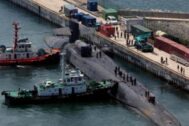
US - Korea
May — August 2023Diff’rent Strokes for Different Folks
The May-August 2023 reporting period saw further divergence between Washington’s relations with Seoul and Pyongyang. This dynamic was an acceleration of a trend already evinced at the April Joe Biden-Yoon Suk-yeol summit that produced the Washington Declaration modernizing US-South Korea extended deterrence, and the alliance as a whole. Washington-Seoul bonhomie contrasts manifestly with Washington-Pyongyang relations, whose level of hostility remains the same as four months ago, 14 months ago, or 24 months ago. That is, all the positive action during summer 2023 came from the continued dramatic growth in the US-South Korea alliance, notably via the extraordinary formation of a genuine trilateral US-South Korea-Japan quasi-alliance. This development has been in the works for the last 18-24 months, was given momentum by improving South Korea-Japan government relations and a Yoon-Kishida summit in May, and was concretely founded in August at the US-South Korea-Japan summit at Camp David.
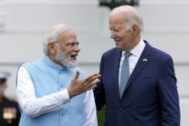
US - India
May — August 2023From Non-Alignment to Realignment
This chapter was made possible through a grant from the Hindu American Foundation.
The US and India expanded cooperation across various domains in the second reporting period of 2023. The two moved to materialize projects and initiatives that were conceived in the first quarter, in wide-ranging domains with significant geopolitical and geoeconomic scope including defense cooperation, critical and emerging technologies, and infrastructure development. While New Delhi continued to straddle groupings such as BRICS, Shanghai Cooperation Organization, and the Quadrilateral Security Dialogue, the US-India partnership broke ground on more initiatives than any of India’s other bilateral relationships. Modi and Biden visited each other’s capitals and reaffirmed their commitment to a rules-based international order. The rousing reception Modi received in Washington and the continued US preeminence in most major trade and technology initiatives conceived by India highlighted the growing partnership between the two democracies. And the two leaders, while facing elections next year, seem willing to work together on common global priorities—sometimes at domestic political costs.

US - Southeast Asia
May — August 2023New Leaders Challenged by US-China Rivalry
Over the summer three Southeast Asian nations—Thailand, Cambodia, and Indonesia—conducted political contests or prepared for them, with Washington and Beijing watching closely for shifts in alignments or opportunities to make inroads with new leaders. Despite this, and possibly because of it, China made bold moves in the South China Sea and caused outcry in the region with the release of a map supporting its claims to the “Nine-Dash Line.” Beijing also showed signs of worry about Russian inroads into Southeast Asia and the Indo-Pacific region. The high-profile visit to Washington of Philippine President Ferdinand “Bongbong” Marcos, Jr. enabled both countries to reconfirm the US-Philippines alliance publicly, although it gave little indication of where the broader relationship may be headed. ASEAN continued to make little headway in helping to resolve the conflict in Myanmar; and the 2023 chair, Jakarta attempted to redirect the group toward economic goals and a common approach to looming food insecurity in the region.
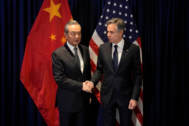
China’s recently recognized position as Southeast Asia’s leading power faces growing challenges from efforts of the Biden administration to counter Chinese ambitions and advance US regional influence. Beijing has stuck to practices of strong diplomatic engagement, economic enticement, and a range of coercive measures that have been broadly successful in the past but seem to have failed badly in the Philippines, now moving into the US orbit.
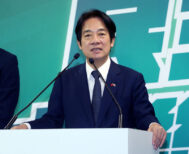
China - Taiwan
May — August 2023Stark Choices Confront Taiwan Voters
Taiwan’s presidential election campaign has begun. Lai Ching-te, Taiwan’s vice president and Democratic Progressive Party (DPP) candidate, Hou Yu-ih from the Nationalist (Kuomintang, or KMT) Party, Ko Wen-je of Taiwan People’s Party (TPP), and independent Terry Gou offer Taiwan voters four different visions of Taiwan’s future relationship with China. As senior US and Chinese officials resumed long-stalled face-to-face meetings, China warned once again that it has no room for compromise or concession on Taiwan. Yet, when Lai completed almost invisible transits through the US en route to Paraguay and back, China’s military response seemed almost pro-forma. When US, Japanese, and South Korean leaders reiterated at the trilateral Camp David summit their staunch opposition to China’s intimidation, China chose to interpret their words as one more promise to support Taiwan. The US accelerated weapons deliveries to Taiwan and expanded training for Taiwan’s military, and Taiwan announced that its defense budget will increase by 7.5% in 2024. Taiwan’s TSMC moved forward on constructing its Arizona factory despite some hiccups, and the US and Taiwan signed a long-awaited trade deal—the first part of their 21st Century Trade Initiative.
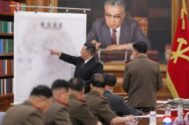
North Korea - South Korea
May — August 2023In Both Pyongyang and Seoul, an Ominous Hardening
In mid-2023, the (non-existent) relations between the two Koreas got even worse, if that were possible. Confronting enlarged US-ROK military exercises, and the first visit of a US nuclear-armed submarine to the peninsula since 1981, Pyongyang’s nuclear threats grew ever more frenzied. In Seoul, President Yoon Suk Yeol institutionalized his hard line by downsizing and repurposing the Ministry of Unification (MOU). Criticizing MOU for acting in the past as a support department for North Korea, Yoon evidently conceives its future role as being to hinder Kim Jong Un’s regime—publicizing its human rights abuses, for instance—rather than help. Much as the DPRK’s ever-expanding WMD threat requires robust deterrence, for Seoul to start emulating Pyongyang’s unalloyed hostility hardly seems conducive to peace. The period under review also saw two attempts by North Korea to put a spy satellite into orbit; both failed. By contrast, the North’s missile launches hardly ever go wrong these days. The large solid-fuel Hwasong-18 ICBM, with a 15,000-km (9,300-mile) range, which first flew in April, had a second successful test on July 12.
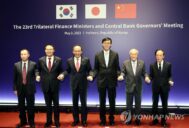
China - Korea
May — August 2023Economic Security Dilemmas
PRC Ambassador to South Korea Xing Haiming’s public statement in June sharpened Beijing-Seoul frictions following President Yoon Suk Yeol’s Taiwan remarks in an April interview, sparking mutual accusations of interference in internal affairs. Multilateral engagements offered opportunities to reaffirm China-ROK relations through bilateral talks between China’s Commerce Minister Wang Wentao and South Korea’s Trade Minister Ahn Duk-geun (May), Defense Ministers Li Shangfu and Lee Jong-sup (June), Foreign Ministers Wang Yi and Park Jin (July), Finance Ministers Liu Kun and Choo Kyung-ho (July), and Trade Ministers Wang Shouwen and Ahn (August). The revival of high-level exchanges, Beijing’s lifting of travel restrictions on South Korea in August, and North Korea’s border reopening that same month are sources of optimism in China-Korea relations despite overarching tensions. Discord remains on regional security priorities, South Korea’s overt alignment with the United States under the Yoon administration, and the escalating US-China technology war. Meanwhile, Chinese and Russian delegations joined Kim Jong Un in Pyongyang to celebrate the 70th anniversary of the end of the Korean War, reflecting the shape of North Korea’s first post-COVID diplomatic activity.

Japan - China
May — August 2023From Talking Past Each Other to Barely Talking
China’s mid-August decision to allow group travel to Japan days ahead of the 45th anniversary of the Treaty of Peace and Friendship between the two nations as well as indications that China would be open to a meeting between Xi Jinping and Fumio Kishida on the sidelines of the Group of 20 (G20) leaders’ summit in India in September gave hope for improvement in China-Japan ties. The optimism proved short-lived. Chinese media responded that Japan would first have to turn away from following the US lead, stop encouraging Taiwanese pro-independence forces, and strictly abide by the four communiques signed between Beijing and Tokyo. China’s protests over Japan’s release of radioactive water culminated in a total ban on Japanese marine products. The PRC also expressed annoyance with Japanese restrictions on the export of computer chips, the ministry of defense’s release of its annual Defense of Japan 2023 white paper, Tokyo’s closer relations with NATO, and its tripartite agreement with South Korea and the US. Japan expressed uneasiness with Russia-China cooperation and became concerned with renewed Chinese interest in Okinawa, with its purchases of Japanese land, cyberattacks, and its refusal to import Japanese seafood products.

Japan - Korea
May — August 2023Camp David: Institutionalizing Cooperation Trilaterally
Japan-South Korea relations are going strong. In the months leading up to the historic Camp David trilateral summit in August, we saw the return of shuttle diplomacy between Korea and Japan. If President Yoon Suk Yeol’s March visit to Japan was groundbreaking, Prime Minister Kishida Fumio’s May visit to Seoul signified the continued momentum of improving bilateral ties. The Aug. 18 trilateral summit meeting, where President Biden, President Yoon, and Prime Minister Kishida announced bold steps to cement trilateral cooperation into the institutional fabric of the relationship, represents the deepest attempt in recent memory. A successful trilateral summit like this one was possible only because Seoul and Tokyo mended their bilateral ties. A positive cycle is expected the other way around, as well. For example, the “Commitment to Consult” —to expeditiously “share information, align messaging and coordinate response actions” among the three leaders—will likely create more incentives and opportunities for Seoul and Tokyo to keep bilateral relations friendly and cooperative.
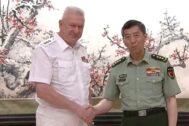
China - Russia
May — August 2023Testing the Limits of Strategic Partnership
In the summer months, both the upper and lower limits of the China-Russia strategic partnership were put to considerable tests. In the West, China’s peace-probing effort continued despite virtual stalemate in the Ukraine war and its sudden twists and turns (drone attacks on the Kremlin and Wagner mutiny). Beijing treaded carefully in restoring relations with Kyiv with the new Ukrainian ambassador in place. In the East, Russian and Chinese militaries conducted a series of aerial and naval exercises/operations with unprecedented scope and closer interoperability for almost three months (from early June to late August), something not seen even at the peak of the Sino-Soviet alliance in the 1950s. All of this occurred against the backdrop of increasingly hardened US-led alliance networks both in Indo-Pacific and beyond.
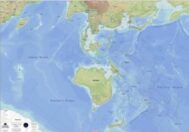
Australia has peeled back China trade coercion as it ramps-up the alliance with the United States to balance China. The Labor government, elected in May 2022, claims a diplomatic thaw with China as a key achievement. The major defense step was agreeing for Australia to get nuclear submarines under the AUKUS agreement with Britain and the United States. The government’s 2023 National Defense Statement describes “an intense contest of values” in the Indo-Pacific, with growing “risks of military escalation or miscalculation.” Because of the worsening strategic environment, the Australian Defense Force is judged “not fully fit for purpose” as the government seeks greater long-range strike capability. The era of alliance integration will see more US troops, planes, and ships in Australia, and the creation of a US-Australia combined intelligence center in Canberra. The contest with China in the South Pacific frames a new Australian aid policy and a greater US role in the islands.